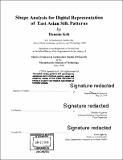Shape analysis for digital representation of East Asian silk patterns
Author(s)
Koh, Hunmin
DownloadFull printable version (14.76Mb)
Other Contributors
Massachusetts Institute of Technology. Department of Architecture.
Advisor
Takehiko Nagakura.
Terms of use
Metadata
Show full item recordAbstract
This thesis examines the East Asian geometric silk pattern. Despite its long history of use in traditional architecture as an ornamental element in Korea and China, a little attempt was made to understand its geometric construction. Also, the connection between the silk patterns in two countries are often neglected because of the lack of systematic archiving. I first present the currently existing examples of silk patterns in Korea and China. Through a comparative analysis, I identify that the pattern is a shared heritage of the region and proses that more holistic approach is required to understand its relation with geometric patterns from other cultures. One of the approach is symmetry analysis, a method used in archeology to identify relevance in material culture between two adjacent cultural groups. Subsequently, I present shape analysis of existing sixfold symmetry silk patterns and argue that the stacking order of basic motifs plays an important role in design of the majority of silk patterns. I devised a symbolic notation system to identify different stacking order between different designs. Based on the analysis, I introduce an automated pattern generator which creates patterns with a specific symmetry in batches. The produced images can be used to train a symmetry classifier based on a machine learning model. I discuss possible implementations of the pattern generator and the symmetry classifier model and outline future development and challenges.
Description
Thesis: S.M. in Architecture Studies, Massachusetts Institute of Technology, Department of Architecture, 2018. Cataloged from PDF version of thesis. Includes bibliographical references (pages 58-61).
Date issued
2018Department
Massachusetts Institute of Technology. Department of ArchitecturePublisher
Massachusetts Institute of Technology
Keywords
Architecture.